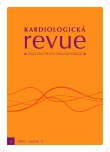Transcatheter aortic valve implantation
Authors:
J. Vojáček 1; J. Šťásek 1; J. Bis 1; M. Brtko 2; J. Vojáček 2; J. Harrer 2
Authors‘ workplace:
1. interní klinika LF UK a FN Hradec Králové
1; Kardiochirurgická klinika LF UK a FN Hradec Králové
2
Published in:
Kardiol Rev Int Med 2009, 11(3): 143-147
Overview
Surgical replacement of aortic valve is the treatment of choice in patients with symptomatic aortic stenosis or stenosis causing impairment of left ventricular function. The procedure is in indicated cases performed with low mortality and good long‑term outcome, even in older patients. Aortic valve replacement increases survival in a number of operated subgroups. Transcatheter Aortic Valve Implantation (TAVI) has been developing fast over the recent years as an option in patients in whom the traditional surgical aortic valve replacement would represent a too high risk. This technique is indicated in patients with high EuroSCORE (above 10–20), most often as a result of co-morbidities or of other reasons, for example as a consequence of previous cardiac surgery (most frequently previous coronary revascularization with functional bypass). Success of the procedure depends on operator‘s experience and exceeds 90%. Aortic valve gradient falls to near zero values immediately after the implantation and aortic valve area of 1.5–1.8 sqcm is being achieved; mild to moderate, mostly paravalvular, aortic regurgitation is observed in about half of the patients. The incidence of severe aortic regurgitation has fallen below 5% following improved implant selection. 30-day mortality is 5–18%, the incidence of acute myocardial infarction 2–11%. The incidence of vascular complications (between 10–15%) and conduction disorders with the need for pacemaker implantation in patients treated with self-expanding valve remain an issue.
Keywords:
aortic stenosis – transcatheter treatment – transcatheter aortic valve implantation
Sources
1. Čerbák R. Aortální stenóza – nejčastější chlopenní vada současnosti. Cor Vasa 2005; 47: 409–411.
2. Chiam PT, Ruiz CE. Percutaneous transcatheter aortic valve implantation: Evolution of the technology. Am Heart J 2009; 157: 229–242.
3. Popelová J, Benešová M, Brtko M et al. Doporučené postupy pro diagnostiku a léčbu chlopenních srdečních vad v dospělosti. Cor Vasa 2007; 49 (Suppl 11): 6–46.
4. Vahanian A, Baumgartner H, Bax J et al. Task Force on the Management of Valvular Hearth Disease of the European Society of Cardiology; ESC Committee for Practice Guidelines. Guidelines on the Management of Valvular Heart Disease. The task force on the management of valvular heart disease of the European Society of Cardiology. Eur Heart J 2007; 28: 230–268.
5. Nashef SA, Roques F, Michel P et al. The EuroSCORE study group. European system for cardiac operative risk evaluation (EuroSCORE). Eur J Cardiothorac Surg 1999; 16: 9–13.
6. Roques F, Michel P, Goldstone AR et al. The logistic EuroSCORE. Eur Heart J 2003; 24: 881–882.
7. Edwards FH, Grover FL, Shroyer AL et al. The Society of Thoracic Surgeons National Cardiac Surgery Database: current risk assessment. Ann Thorac Surg 1997; 63: 903–908.
8. Ghanbari H, Kidane AG, Burriesci G et al. Percutaneous Heart Valve Replacement: An Update. Trends in Cardiovasc Med 2008; 18: 117–125.
9. Vahanian A, Alfieri O, Al-Attar N et al. Transcatheter valve implantation for patients with aortic stenosis: a position statement from the European Association of Cardio-Thoracic Surgery (EACTS) and the European Society of Cardiology (ESC), in collaboration with the European Association of Percutaneous Cardiovascular Interventions (EAPCI). EuroIntervention 2008; 4: 193–199.
10. Cribier A, Eltchaninoff H, Bash A et al. Percutaneous transcatheter implantation of an aortic valve prosthesis for calcific aortic stenosis: first human case description. Circulation 2002; 106: 3006–3008.
11. Cribier A, Eltchaninoff H, Tron C. First human transcatheter implantation of an aortic valve prosthesis in a case of severe calcific aortic stenosis. Ann Cardiol Angeiol (Paris) 2003; 52: 173–175.
12. Vojáček J. První katetrizační implantace aortálních chlopní v České republice. Interv Akut Kardiol 2009; 8: 6–8.
13. Želízko M, Janek B, Netuka I et al. Perkutánní implantace aortální chlopně u nemocné s těsnou aortální stenózou. Interv Akut Kardiol 2009; 8: 43–46.
14. Šťásek J, Vojáček J, Bis J et al. První zkušenost s perkutánní transfemorální implantací chlopně Edwards SAPIEN™ u nemocných s aortální stenózou. Interv Akut Kardiol 2009;8: 47–51.
15. Harrer J, Vojáček J, Šťásek J et al. První zkušenost s transapikální implantací chlopně u nemocných s aortální stenózou. Interv Akut Kardiol 2009; 8: 100–104.
16. EuroSCORE. European System for Cardiac Operative Risk Evaluation. EuroScore Interactive Calculator. [http://www.euroscore.org/calc.html].
Labels
Paediatric cardiology Internal medicine Cardiac surgery CardiologyArticle was published in
Cardiology Review

2009 Issue 3
Most read in this issue
- ECG monitoring with Holter monitor
- Current opinions about the role of mild hyperhomocysteinaemia as a risk factor of cardiovascular diseases
- Uric acid and cardiorenal risk
- HRT and cardi ovascular risk
